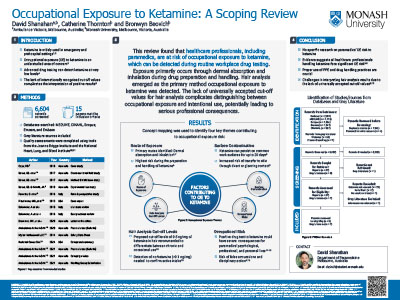ABSTRACTS
What Is Known About Exposure Among Individuals Authorized to Administer and Handle Ketamine Across Different Occupational Settings: A Scoping ReviewAuthor: David Shanahan, Catherine Thornton, Rodney Evans, and Bronwyn Beovich | | Associate Authors:
Introduction: Ketamine is frequently handled and administered in emergency situations by paramedics. However, the prevalence and extent of their occupational exposure (OE) to ketamine remains an understudied area of concern. While advanced drug-testing technologies can detect ketamine and its metabolites at extremely low levels over extended periods, interpreting positive results in the context of OE is challenging due to the lack of internationally recognized cut-off values distinguishing legitimate exposure from illicit use, leading to potential misconduct allegations among healthcare professionals. Objective: To systematically map and synthesize the available evidence on OE to ketamine among individuals authorized to administer or handle the drug across various clinical and occupational settings. Methods: Predetermined search terms related to the research question were used to search MEDLINE (via OVID), CINAHL Plus, Scopus, Emcare, and Embase for English-language articles. Gray literature was found using advanced Google search techniques and gray literature databases. Results were uploaded to the Covidence platform and screened for inclusion by independent reviewers adhering to the predefined inclusion and exclusion criteria, with a third reviewer acting as an arbitrator when necessary. The selection of final articles was based on the JBI-recommended approach for source selection and data extraction. Results: From 5395 studies screened, 16 articles were included and revealed key characteristics on what is known about ketamine exposure and occupational settings that are at a higher risk of exposure. Dermal exposure from preparation, handling, and contacting contaminated surfaces was the primary route of OE, with hair analysis being the main method used to detect ketamine and its metabolite norketamine. The review identified occupational settings with a high risk of ketamine exposure that could be transferrable to paramedic practice. It also highlighted the need for established cut-off levels to differentiate between OE and illicit use. Conclusions: This scoping review highlighted the OE risks that paramedics and other healthcare professionals may face when administering or handling ketamine. Further research is needed to better understand the exposure risks and to develop guidelines to protect healthcare professionals from misconduct allegations.
|

